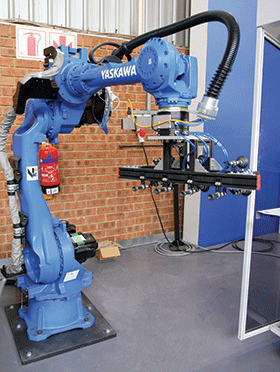Why artificial intelligence matters in robotic technology
March 2024
Motion Control & Drives

Yaskawa is a pioneer in innovative automation and robotics technologies. Artificial intelligence (AI) has emerged as a groundbreaking force in many sectors, including transportation, healthcare, finance and agriculture. In robotics, AI is redefining the landscape, and also human-machine interaction. Andrew Crackett, managing director of Yaskawa Southern Africa, gives his insight into the role of AI in robotics technology, with its advantages and challenges, and makes predictions for the future.
The speed at which AI is being integrated into our rapidly advancing digital world makes it critical for industries to adopt it, and this is especially true for robotics. Crackett calls AI “the cognitive powerhouse behind the physical capabilities of robots, influencing everything from design and functionality to adaptability in diverse environments”. AI provides robots with unmatched precision and efficiency, optimising actions through machine learning algorithms for enhanced productivity and accuracy. It also improves safety standards, as it enables robots to navigate complex environments, detect potential hazards, and execute tasks with a focus on minimising risks, which promotes worker safety. AI also enables robots to make split-second decisions based on data analysis – a critical capability in dynamic environments like manufacturing floors, or autonomous vehicles that work along a production line.
It is equally critical to acknowledge AI’s potential shortcomings. As AI becomes standard in robotics, ethical concerns may arise, which demand careful consideration and regulation regarding the ethical use and accountability of AI-driven robots. Crackett explains that “overcoming challenges and addressing any limitations in current AI models is essential for the continued advancement of AI-driven robotics”. Harmonious collaboration between AI-driven robots and human workers is necessary, as the integration of collaborative robots (cobots), need not mean the elimination of manual labour. Cobots are designed to work alongside humans, taking on more labour-intensive tasks, and freeing up capacity for upskilling and career development.
The future looks promising for AI and machine learning. Robots are capable of adapting, learning, and performing increasingly complex tasks. “Synergy between humans and robots is key, with AI facilitating seamless collaboration, complementing human skills, and augmenting workforce capabilities. A focus on ethical development is imperative for the future of AI in robotics, ensuring transparent and ethical AI practices in order to build trust and ensure responsible deployment across industries,” concludes Crackett.
Further reading:
WEBER-HYDRAULIK modernises warehouse in record time
Motion Control & Drives
WEBER-HYDRAULIK is a leading international specialist in customised hydraulic solutions. After its old buffer warehouse had become outdated and was partially worn out mechanically, the decision was made to completely renovate it.
Read more...
OMC deploys cobots to improve throughput ten times
Motion Control & Drives
OMC, a pioneer in optoelectronics design and manufacture, is investing to introduce innovative cobot technology onto its fibre optic production line.
Read more...
Yaskawa Southern Africa launches laser welding cell
Yaskawa Southern Africa
Motion Control & Drives
Yaskawa Southern Africa has partnered with Industrial Manufacturing Systems South Africa to introduce the Megmeet laser welding cell, a breakthrough solution combining precision robotics with cutting-edge laser technology.
Read more...
Next-gen planetary gearboxes
SEW-EURODRIVE
Motion Control & Drives
Leading the way in planetary gear unit innovation, SEW-EURODRIVE is extending its reach across a growing range of industries, delivering the advantages of this powerful technology through locally engineered solutions that ensure faster lead times.
Read more...
Record-breaking dragline relocation
Motion Control & Drives
Draglines are key pieces of equipment in open-pit mining. BHP Mitsubishi Alliance entrusted Mammoet with the relocation of a 3100 ton Marion 8050 dragline from one end of the Peak Downs coal mine in Queensland, Australia to another, a full 27 km away.
Read more...
igus expands 3D printing capabilities
igus
Motion Control & Drives
Motion plastics specialist, igus South Africa has introduced a new 3D printing service capable of producing custom parts in two engineering-grade polymers with exceptional strength and without the need for lubrication.
Read more...
Bühler adds new die refurbishment machine
Motion Control & Drives
Bühler has reinforced its commitment to customers in southern Africa with the installation of a new die refurbishment machine at its Johannesburg workshop.
Read more...
SEW-EURODRIVE drives innovation at automotive plant
SEW-EURODRIVE
Motion Control & Drives
[Sponsored] A major automotive manufacturer in Gauteng has boosted its operational efficiency, safety and energy savings with the installation of SEW-EURODRIVE’s advanced MOVIGEAR mechatronic drive system in its newly expanded buffering zone.
Read more...
Reimagining rotation for a circular and sustainable future
SKF South Africa
Motion Control & Drives
Through the design and manufacture of components with sustainability at their core, SKF is reimagining the future of rotation, rolling away from traditional, consumable-based thinking toward a smarter, more sustainable circular approach.”
Read more...
Optimising operational efficiencies through advanced filtration systems
Bearing Man Group t/a BMG
Motion Control & Drives
Filtration is the only effective defense against wear and tear when contaminants are present. It is therefore critical that effective filter components are correctly used to ensure dependable performance, high efficiency and extended service life of machinery and vehicles.
Read more...


